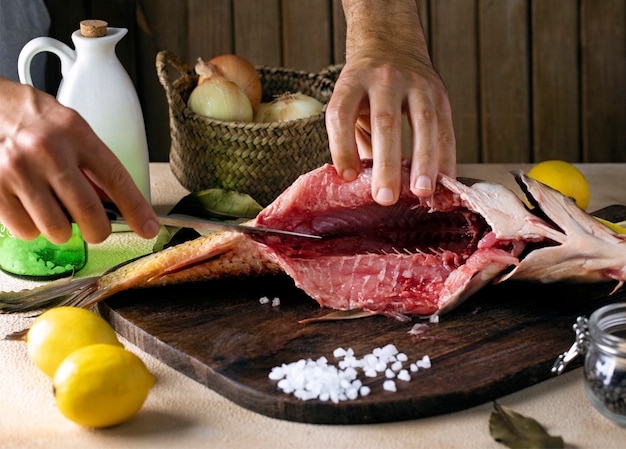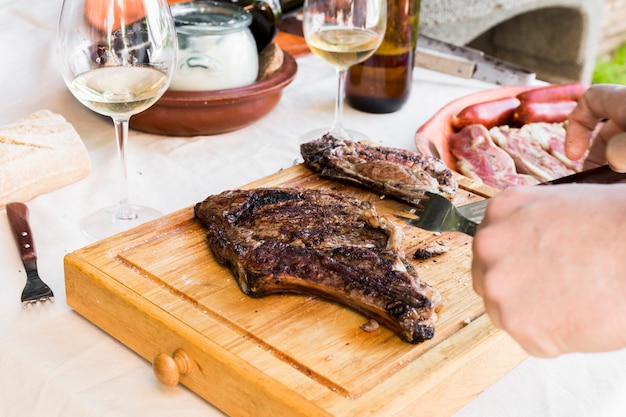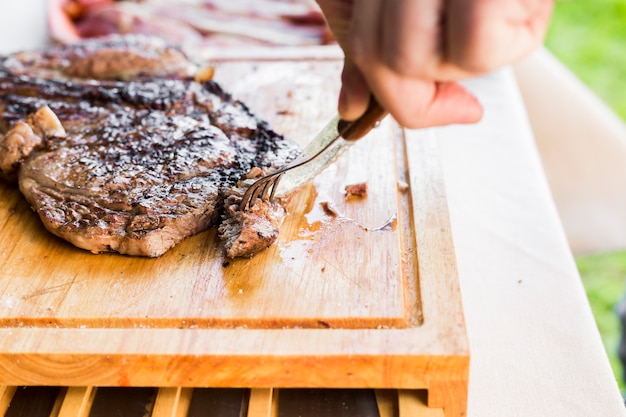Let’s face it, there are few things more satisfying than a perfectly cooked beef rib steak. It's a cut of meat that oozes indulgence, with its rich marbling and undeniable flavor. It’s not just a steak; it’s an experience. And, while the concept of cooking a steak might seem simple, the journey to achieving that juicy, tender, and perfectly seared masterpiece is one that deserves careful attention.
Over the years, I’ve become a bit obsessed with perfecting my steak game, trying countless techniques, and experimenting with different cuts. From the humble pan-fry to the impressive reverse sear, I’ve learned a thing or two about getting that perfect bite. And I’m excited to share my knowledge with you, taking you on a journey to become a true beef rib steak connoisseur.
This guide is more than just a recipe; it's a deep dive into the world of beef rib steak, covering everything from selecting the perfect cut to understanding the science behind the perfect sear. So grab your favorite beverage, get comfortable, and let’s embark on this delicious adventure together.
Part 1: The Cut

Choosing the Perfect Cut
The journey to a phenomenal steak begins with the cut. Beef rib steak, also known as prime rib, is a cut that’s synonymous with decadence. It comes from the rib section of the beef, nestled between the chuck and the loin, and boasts a generous amount of marbling—the intramuscular fat that gives it its luscious flavor and tenderness.
There are a few different cuts within the rib section, each with its own personality. Here’s a rundown of the most popular choices:
- Prime Rib: This is the king of the rib cuts, a thick, bone-in masterpiece often cooked as a roast. It’s perfect for feeding a crowd, offering a luxurious dining experience. The flavor is rich, buttery, and incredibly satisfying.
- Rib Eye: This cut is a boneless gem, perfect for grilling or pan-frying. It’s leaner than prime rib, offering a more intense, concentrated flavor. It’s a classic choice for those who enjoy a slightly bolder taste.
- rib roast: This cut is closely related to prime rib, often thicker and available for cooking as a whole roast or split into individual steaks. It’s a great option for those looking for a more substantial steak.
Selecting the right cut depends on your personal preferences and the occasion. If you’re looking for a show-stopping centerpiece, prime rib is the way to go. If you want a smaller, more manageable steak, a rib eye is a perfect choice. And for those seeking a substantial cut, the rib roast is a great contender.
Here are a few things to consider when choosing your cut:
- Thickness: A thicker steak will take longer to cook, so if time is of the essence, opt for a thinner cut. However, a thicker steak will retain more moisture and offer a more tender texture.
- Marbling: The more marbling, the more flavor and tenderness you can expect. Look for steaks with a good distribution of fat throughout the meat.
- Bone-in or Boneless: Bone-in steaks offer a more intense flavor and often retain more moisture due to the bone’s ability to conduct heat. However, they can be a bit more challenging to cook evenly. Boneless cuts are easier to cook and slice, but may lack the depth of flavor that a bone-in cut provides.
Personally, I prefer bone-in steaks for their unique flavor and tenderness. But don’t shy away from boneless cuts; they’re a great option for convenience and ease of cooking.
Part 2: Preparing the Steak

Setting the Stage for a Delicious Experience
You’ve got the perfect cut in hand, now it’s time to get it ready for its culinary transformation. This step, while seemingly straightforward, is crucial in ensuring a steak that’s cooked to perfection.
Here's a step-by-step guide to preparing your beef rib steak:
- Pat it Dry: Start by patting your steak dry with paper towels. This simple step is essential for achieving a beautiful, crispy sear. Moisture on the surface of the steak will inhibit browning, so getting rid of excess water is a must.
- Season Generously: Now it’s time to unleash the flavors! Season your steak liberally with salt and pepper. Don’t be afraid to use a generous hand; a good seasoning will enhance the natural flavors of the beef. For extra oomph, you can add a pinch of garlic powder, onion powder, or even a touch of smoked paprika.
- Let it Rest: Allow your steak to come to room temperature for about 30 minutes before cooking. This might seem counterintuitive, but it’s a crucial step for even cooking. A steak that’s chilled from the fridge will cook unevenly, leading to a less desirable result. Bringing the steak to room temperature allows it to cook more evenly, ensuring a tender and juicy outcome.
I always season my steaks with a healthy dose of salt and pepper, and I’m a big fan of adding a pinch of smoked paprika for a touch of warmth and smokiness. But feel free to experiment with your own favorite seasonings!
The Art of Dry-Brining
Here’s a little secret that can take your beef rib steak from delicious to divine: dry-brining. It’s a simple technique that can drastically improve the tenderness and flavor of your steak.
Here’s how it works: Generously sprinkle your steak with salt, then leave it uncovered in the refrigerator for 12-24 hours. The salt draws out moisture from the steak, and as the steak sits, that moisture is reabsorbed, resulting in a more tender and flavorful steak. The process also helps to break down the protein structure, further enhancing tenderness.
Dry-brining might sound like a lot of work, but trust me, the results are worth it. I usually dry-brine my steaks for at least 12 hours, but if you have time for longer, go for it! Your tastebuds will thank you.
Part 3: Cooking the Steak

Finding the Right Cooking Method
Now that your steak is prepped and ready to go, it’s time to choose your cooking method. Beef rib steak is a versatile cut, lending itself to various techniques, each offering its own unique flavor and texture.
Here are some of the most popular and effective methods for cooking beef rib steak:
- Grilling: This classic method is a favorite for many, offering a delicious smoky flavor and those iconic grill marks. Grilling is best suited for steaks with a good amount of marbling, as the heat will help render the fat, adding to the richness and flavor.
- Pan-Frying: This is a quick and easy option, perfect for those nights when you don’t have a grill or want a faster cooking time. Pan-frying achieves a beautiful sear and offers good control over the cooking temperature.
- oven roasting: This method is ideal for thick cuts of beef rib steak, like prime rib. The oven’s gentle heat allows the steak to cook slowly and evenly, resulting in a tender and juicy masterpiece.
- Reverse Searing: This technique is gaining popularity for good reason. It involves cooking the steak low and slow in the oven or on the grill, then finishing it off with a quick sear over high heat. This method ensures a steak that’s perfectly cooked throughout, with a beautiful, crispy crust.
The best cooking method for you depends on your preferences, equipment, and the occasion. I personally love the smoky flavor and char that grilling brings, but pan-frying is a reliable and convenient option when I’m pressed for time.
Key Tips for Cooking Excellence
Here are some tips to keep in mind, regardless of the cooking method you choose:
- Preheat Your Cooking Surface: Whether you’re using a grill, pan, or oven, preheating your cooking surface is crucial for achieving a crisp sear. A hot surface will help to create a beautiful crust and prevent the steak from sticking.
- Don’t Overcrowd the Pan: If you’re pan-frying your steak, make sure to cook it in a single layer. Overcrowding the pan will lower the temperature, hindering the searing process and leading to uneven cooking.
- Resist the Urge to Move: When searing your steak, avoid moving it around too much. Let it rest on the hot surface to develop a nice, crispy crust. Frequent flipping will interrupt the searing process and result in a less desirable crust.
- Embrace the meat thermometer: The best way to ensure your steak is cooked to perfection is to use a meat thermometer. Insert it into the thickest part of the steak, making sure it doesn’t touch the bone.
- Let It Rest: After cooking, allow your steak to rest for at least 5-10 minutes before slicing. This crucial step allows the juices to redistribute throughout the steak, resulting in a more tender and juicy experience.
Remember, patience is key when cooking a steak. Don’t rush the process; let the heat do its magic. And don’t be afraid to experiment with different cooking methods and temperatures to find your perfect steak.
Part 4: Understanding Doneness
Navigating the Degrees of steak perfection
Doneness is a personal preference, and there are many different ways to enjoy your beef rib steak. Some like their steaks rare, with a cool red center, while others prefer them well done, cooked through and brown.
Here’s a guide to the different levels of doneness and their corresponding internal temperatures:
| Doneness | Internal Temperature (°F) | Internal Temperature (°C) | Description |
|---|---|---|---|
| Rare | 125-130 | 52-54 | Cool red center, warm outer edges |
| Medium Rare | 130-135 | 54-57 | Warm red center, pink outer edges |
| Medium | 135-140 | 57-60 | Pink center, warm throughout |
| Medium Well | 140-145 | 60-63 | Slightly pink center, mostly brown |
| Well Done | 145-150 | 63-65 | Completely brown, cooked through |
I personally prefer my steaks medium-rare, but I encourage you to explore and discover what suits your palate. Remember, the goal is to achieve a level of doneness that you find both delicious and satisfying.
Part 5: Reverse Searing
The Art of Patience and Precision
Reverse searing has become a favorite technique among serious steak enthusiasts. It’s a method that combines patience and precision, resulting in a steak that’s cooked perfectly evenly, with a beautifully crisp crust.
Here’s how reverse searing works:
- Low and Slow: Start by cooking your steak in the oven at a low temperature, around 225°F (107°C). The goal is to slowly cook the steak to your desired level of doneness without searing it. This slow cooking method allows the steak to cook evenly throughout, resulting in a tender and juicy center.
- High Heat Finale: Once the steak has reached your desired level of doneness, crank up the heat! Sear it over high heat for about 1-2 minutes per side. This quick sear will create a crisp, flavorful crust and seal in the juices.
Reverse searing might seem like a more involved process, but the results are truly exceptional. It’s a method that offers a level of control and predictability, ensuring a steak that’s cooked to perfection, from the center to the crust.
Part 6: The Resting Period
The Importance of a Well-Deserved Break
After you’ve expertly cooked your steak to perfection, it’s time to give it a well-deserved break. Letting your steak rest for at least 5-10 minutes before slicing might seem like a minor detail, but it's a crucial step that significantly impacts the tenderness and juiciness of your steak.
Here’s the science behind it: When you cook a steak, the heat causes the juices to push towards the center. If you slice into the steak immediately, those juices will spill out, leaving you with a dry and disappointing steak. However, when you let the steak rest, the juices have time to redistribute throughout the meat. This results in a more flavorful and tender steak, with the juices evenly distributed throughout.
I always make sure to let my steaks rest for at least 10 minutes, sometimes even longer for thicker cuts. I usually cover the steak loosely with foil to keep it warm and prevent it from drying out.
Part 7: Serving and Enjoying Your Steak
Elevate the Dining Experience
You’ve reached the pinnacle of your culinary journey, and it’s time to savor the fruits of your labor. Beef rib steak is a delicious treat on its own, but you can elevate the experience by pairing it with the right accompaniments.
Here are some classic pairings that complement the rich flavors of beef rib steak:
- Red Wine: A full-bodied red wine, such as Cabernet Sauvignon, Merlot, or Shiraz, provides a delightful contrast to the richness of the steak. The tannins in red wine help to cleanse the palate, enhancing the flavor of the steak.
- Potatoes: mashed potatoes, baked potatoes, or roasted potatoes offer a comforting and familiar pairing. I love a creamy mashed potato with a touch of butter and chives, providing a perfect contrast to the savory steak.
- Asparagus: Roasted or grilled asparagus adds a touch of freshness and lightness to the dish. The slightly bitter flavor of asparagus complements the richness of the steak, offering a well-balanced flavor profile.
- green beans: Steamed or sautéed green beans provide a healthy and satisfying side dish. Their subtle flavor allows the steak to shine, while their texture adds a nice contrast.
I also enjoy serving my steak with a simple salad, using mixed greens, a light vinaigrette, and a few slices of fresh tomatoes. This adds a refreshing element and helps to balance the richness of the steak.
Remember, the most important thing is to create a meal that you enjoy. Don’t be afraid to experiment with different pairings and find what suits your taste.
Part 8: FAQs
Answers to Your Burning Questions
Here are some common questions about cooking beef rib steak, along with their answers:
- What’s the best way to cook a thick beef rib steak? The best way to cook a thick beef rib steak is to roast it in the oven. The gentle heat of the oven allows the steak to cook slowly and evenly, resulting in a tender and juicy center. You can also try the reverse searing method for thicker cuts, as it provides exceptional even cooking.
- How do I know if my steak is done? The best way to ensure your steak is cooked to your desired level of doneness is to use a meat thermometer. Insert it into the thickest part of the steak, making sure it doesn’t touch the bone.
- What if I overcook my steak? Don’t panic! It’s not the end of the world. While a perfectly cooked steak is ideal, an overcooked steak can still be enjoyable. Just make sure to let it rest for a bit longer to allow the juices to redistribute, and consider adding a flavorful sauce to compensate for any dryness.
- What are some good ways to use leftover steak? Leftover beef rib steak can be transformed into delicious meals. Slice it thinly and add it to a salad, or dice it and use it in a stir-fry. You can also create a hearty soup or stew using the leftover steak, adding a rich and savory element to the dish.
- Where can I buy the best beef rib steak? For the best selection and quality, I recommend visiting your local butcher shop. Butchers are experts on meat and can guide you towards the perfect cut for your needs. They can also provide advice on how to best prepare and cook your steak.
Now that you’re armed with this knowledge, go forth and conquer the art of cooking beef rib steak! Remember, the journey to a perfectly cooked steak is a rewarding one, filled with delicious possibilities. So grab your tools, embrace the process, and enjoy the journey.
Everyone is watching

Corn on the Cob: The Ultimate Guide to Perfectly Cooked Ears
Healthy MealsAh, corn on the cob. Just the name evokes images of sunny days, barbecues, and that sweet, juicy flavour that ...

Perfect Pork Roast Oven Cooking Time: A Guide to Delicious Results
Healthy MealsThere's something truly satisfying about a perfectly roasted pork. The aroma alone is enough to make your mout...

Ham Cooking Time: How Long to Bake, Smoke, or Boil a Delicious Ham
Healthy MealsAh, ham. It's a classic, isn't it? A real crowd-pleaser, especially around holidays. And when done right, it'...

Scallops: The Ultimate Guide to Perfect Cooking
Healthy MealsAh, scallops. Those delicate, sweet, and utterly delicious morsels of the sea. They hold a special place in my...

Spaghetti Squash: The Ultimate Guide to Cooking and Serving
Healthy MealsRemember that time you saw spaghetti squash at the supermarket, looking all bumpy and strange, and thought, "W...
